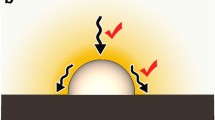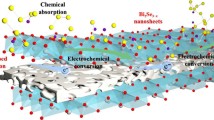Abstract
In this study, we examined the molecular structure of pristine and defective BCN surfaces for the adsorption of lithium polysulfides. We introduced C/B/N vacancies to the 2D BCN surface and observed that the bandgap decreased in the order of BCN > C–BCN > B–BCN > N–BCN. The adsorption of lithium polysulfides on both pristine and defective BCN surfaces was primarily through physisorption. Our results indicated that the N–BCN surface showed good adsorption with smaller lithium polysulfides, while the C–BCN surface bound strongly with longer lithium polysulfides. We found that introducing vacancies in BCN surfaces improved the adsorption of lithium polysulfides, with values comparable to those of other 2D materials. Therefore, we propose that defective BCN surfaces can be effectively utilized as a cathode scaffold for lithium polysulfide capture in lithium–sulfur batteries.






Similar content being viewed by others
Availability of data and material
N/A.
References
L. Wang, T. Zhang, S. Yang, F. Cheng, J. Liang, J. Chen, A quantum-chemical study on the discharge reaction mechanism of lithium-sulfur batteries. J Energy Chem 22(1), 72–77 (2013)
H. Althues, S. Dörfler, S. Thieme, P. Strubel, S. Kaskel, Sulfur cathodes, in Lithium-sulfur batteries. (Wiley, Chichester, 2019), pp.33–69
R.S. Assary, L.A. Curtiss, Molecular level understanding of the interactions between reaction intermediates of Li–S energy storage systems and ether solvents, in Lithium-sulfur batteries. (Wiley, Chichester, 2019), pp.133–146
W. Mark, G.J. Offer, Mechanisms, in Lithium-Sulfur Batteries. (Wiley, Chichester, 2019), pp.129–131
T. Zhang, M. Marinescu, G.J. Offer, Lithium-sulfur model development, in Lithium-sulfur batteries. (Wiley, Chichester, 2019), pp.229–247
S. Waluś, Lithium sulfide, in Lithium-sulfur batteries. (Wiley, Chichester, 2019), pp.147–183
M. Barghamadi, M. Musameh, T. Rüther, A.I. Bhatt, A.F. Hollenkamp, A.S. Best, Electrolyte for lithium-sulfur batteries, in Lithium-sulfur batteries. (Wiley, Chichester, 2019), pp.71–119
G. Minton, Electrochemical theory and physics, in Lithium-sulfur batteries. (Wiley, Chichester, 2019), pp.3–32
R. Purkayastha, Degradation in Lithium-Sulfur Batteries, in Lithium-Sulfur Batteries. (Wiley, Chichester, 2019), pp.185–226
M. Wild, Anode-electrolyte interface, in Lithium-sulfur batteries. (Wiley, Chichester pp, 2019), pp.121–127
R. Demir-Cakan, Li-S Batteries (Book). The Challenges, Chemistry, Materials and Future Perspectives. 2017. https://doi.org/10.1142/q0074
J. Xiao, J. Hu, H. Chen, M. Vijayakumar, J. Zheng, H. Pan, E. Walter, M. Hu, X. Deng, J. Feng, B.Y. Liaw, M. Gu, Z. Deng, D. Lv, S. Xu, C. Wang, J. Liu, Following the transient reactions in lithium-sulfur batteries using an in situ nuclear magnetic resonance (NMR) technique. Nano Lett. 15, 3309–3316 (2015). https://doi.org/10.1021/acs.nanolett.5b00521
K. Zhu, C. Wang, Z. Chi, F. Ke, Y. Yang, A. Wang, W. Wang, L. Miao, How far away are lithium-sulfur batteries from commercialization? Front Energy Res (2019). https://doi.org/10.3389/fenrg.2019.00123
A. Manthiram, Y. Fu, S.-H. Chung, C. Zu, Y.-S. Su, Rechargeable lithium-sulfur batteries. Chem Rev 114(23), 11751–11787 (2014)
A. Manthiram, S.-H. Chung, C. Zu, Lithium-sulfur batteries: progress and prospects. Adv Mater 27(12), 1980–2006 (2015)
H.-J. Peng, J.-Q. Huang, X.-B. Cheng, Q. Zhang, Review on high-loading and high-energy lithium-sulfur batteries. Adv Energy Mater 7(24), 1700260 (2017)
M. Cheviri, S. Lakshmipathi, DFT study of chemical reactivity parameters of lithium polysulfide molecules Li2Sn(1≤n≤8) in gas and solvent phase. Comput Theor Chem 1202, 113323 (2021)
M. Cheviri, S. Lakshmipathi, Nitrogen-doped buckybowls as potential scaffold material for lithium-sulfur battery: a DFT study. Electrocatalysis. (2021). https://doi.org/10.1007/s12678-021-00678-3
M. Vijayakumar, N. Govind, E. Walter, S.D. Burton, A. Shukla, A. Devaraj, J. Xiao, J. Liu, C. Wang, A. Karim, S. Thevuthasan, Molecular structure and stability of dissolved lithium polysulfide species. Phys Chem Chem Phys 16(22), 10923–10932 (2014)
M. Cheviri, S. Lakshmipathi, Cobalt phthalocyanine is a suitable scaffold for lithium polysulfide (Li2Sn n = 2–8). Chem Phys Lett 739, 136942 (2020)
Z. Tong, L. Huang, W. Lei, H. Zhang, S. Zhang, Carbon-containing electrospun nanofibers for lithium–sulfur battery: current status and future directions. J Energy Chem 54, 254–273 (2021)
M. Wang, X. Xia, Y. Zhong, J. Wu, R. Xu, Z. Yao, D. Wang, W. Tang, X. Wang, J. Tu, Porous carbon hosts for lithium-sulfur batteries. Chem A Eur J. 25(15), 3710–3725 (2019). https://doi.org/10.1002/chem.201803153
Y. Yang, W. Sun, J. Zhang, X. Yue, Z. Wang, K. Sun, High rate and stable cycling of lithium-sulfur batteries with carbon fiber cloth interlayer. Electrochim Acta 209, 691–699 (2016)
M.-S. Park, J.-S. Yu, K.J. Kim, G. Jeong, J.-H. Kim, T. Yim, Y.-N. Jo, U. Hwang, S. Kang, T. Woo, H. Kim, Y.-J. Kim, Porous carbon spheres as a functional conducting framework for use in lithium–sulfur batteries. RSC Adv 3(29), 11774–11781 (2013)
M. Zheng, Y. Chi, Q. Hu, H. Tang, X. Jiang, L. Zhang, S. Zhang, H. Pang, Q. Xu, Carbon nanotube-based materials for lithium–sulfur batteries. J Mater Chem A 7(29), 17204–17241 (2019)
R. Fang, S. Zhao, K. Chen, D.-W. Wang, F. Li, Binary graphene-based cathode structure for high-performance lithium-sulfur batteries. J Phys Energy 2(1), 015003 (2020)
K. Weimin, F. Lanlan, D. Nanping, Z. Huijuan, Q. Li, N. Minoo, Y. Jing, C. Bowen, Sulfur-embedded porous carbon nanofiber composites for high stability lithium-sulfur batteries. Chem Eng J. 333, 185–190 (2017)
S. Rehman, K. Khan, Y. Zhao, Y. Hou, Nanostructured cathode materials for lithium–sulfur batteries: progress, challenges and perspectives. J Mater Chem A 5(7), 3014–3038 (2017)
L.-C. Yin, J. Liang, G.-M. Zhou, F. Li, R. Saito, H.-M. Cheng, Understanding the interactions between lithium polysulfides and N-doped graphene using density functional theory calculations. Nano Energy 25, 203–210 (2016)
H.R. Jiang, W. Shyy, M. Liu, Y.X. Ren, T.S. Zhao, Borophene and defective borophene as potential anchoring materials for lithium–sulfur batteries: a first-principles study. J Mater Chem A 6(5), 2107–2114 (2018)
J. Zhao, Y. Yang, R.S. Katiyar, Z. Chen, Phosphorene as a promising anchoring material for lithium–sulfur batteries: a computational study. J Mater Chem A 4(16), 6124–6130 (2016)
S. Mukherjee, L. Kavalsky, K. Chattopadhyay, C.V. Singh, Adsorption and diffusion of lithium polysulfides over blue phosphorene for Li–S batteries. Nanoscale 10(45), 21335–21352 (2018)
T.-Z. Hou, W.-T. Xu, X. Chen, H.-J. Peng, J.-Q. Huang, Q. Zhang, Lithium bond chemistry in lithium-sulfur batteries. Angew Chem Int Ed 56(28), 8178–8182 (2017)
M. Bini, D. Capsoni, S. Ferrari, E. Quartarone, P. Mustarelli, 1 Rechargeable lithium batteries key scientific and technological challenges, in Rechargeable lithium batteries. ed. by A.A. Franco (Woodhead Publishing, New York, 2015), pp.1–17
S. Beniwal, J. Hooper, D.P. Miller, P.S. Costa, G. Chen, S.-Y. Liu, P.A. Dowben, E.C.H. Sykes, E. Zurek, A. Enders, Graphene-like boron–carbon–nitrogen monolayers. ACS Nano 11(3), 2486–2493 (2017)
S. Angizi, M.A. Akbar, M. Darestani-Farahani, P. Kruse, Review—two-dimensional boron carbon nitride: a comprehensive review. ECS J Solid State Sci Technol 9(8), 083004 (2020)
A. Yadav, S.S. Dindorkar, Vacancy defects in monolayer boron carbon nitride for enhanced adsorption of paraben compounds from aqueous stream: a quantum chemical study. Surf Sci 723, 122131 (2022)
S.S. Dindorkar, N. Sinha, A. Yadav, Comparative study on adsorption of volatile organic compounds on graphene, boron nitride and boron carbon nitride nanosheets. Solid State Commun 359, 115021 (2023)
S.S. Dindorkar, R. Vardhan Patel, A. Yadav, Adsorption behavior of graphene, boron nitride and boron carbon nitride nanosheets toward pharmaceutical and personal care products. Comput Theor Chem. 1220, 113995 (2023)
A. Yadav, S.S. Dindorkar, S.B. Ramisetti, N. Sinha, Simultaneous adsorption of methylene blue and arsenic on graphene, boron nitride and boron carbon nitride nanosheets: Insights from molecular simulations. J Water Process Eng. 46, 102653 (2022)
W. Lei, S. Qin, D. Liu, D. Portehault, Z. Liu, Y. Chen, Large scale boron carbon nitride nanosheets with enhanced lithium storage capabilities. Chem Commun 49(4), 352–354 (2013)
S. Thomas, M. Asle Zaeem, A new planar BCN lateral heterostructure with outstanding strength and defect-mediated superior semiconducting to metallic properties. Phys Chem Chem Phys 22(38), 22066–22077 (2020)
J. Hafner et al., The Vienna AB-initio simulation program VASP: an efficient and versatile tool for studying the structural, dynamic, and electronic properties of materials, in Properties of complex inorganic. In solids. ed. by A. Gonis, A. Meike, P.E.A. Turchi (Springer, Boston, 1997)
G. Kresse, J. Hafner, Phys. Rev. B 47, 558 (1993)
Chemcraft - graphical software for visualization of quantum chemistry computations. Version 1.8, build 654. https://www.chemcraftprog.com
P.S.V. Kumar, V. Raghavendra, V. Subramanian, Bader’s theory of atoms in molecules (AIM) and its applications to chemical bonding. J Chem Sci 128(10), 1527–1536 (2016)
T. Lu, F. Chen, Multiwfn: a multifunctional wavefunction analyzer. J Comput Chem 33(5), 580–592 (2012)
X. Ren, B. Wang, J. Zhu, J. Liu, W. Zhang, Z. Wen, The doping effect on the catalytic activity of graphene for oxygen evolution reaction in a lithium–air battery: a first-principles study. Phys Chem Chem Phys 17(22), 14605–14612 (2015)
C.-Y. Liu, E.Y. Li, Adsorption mechanisms of lithium polysulfides on graphene-based interlayers in lithium sulfur batteries. ACS Appl Energy Mater 1(2), 455–463 (2018)
M. Lalitha, S.S. Mahadevan, S. Lakshmipathi, Improved lithium adsorption in boron- and nitrogen-substituted graphene derivatives. J Mater Sci 52(2), 815–831 (2017)
A.L. Arokiyanathan, N. Panjulingam, S. Lakshmipathi, Chemical properties of lithium cluster (Lix, x = 2–8) on stone-wales defect graphene sheet: a DFT study. J Phys Chem C 124(13), 7229–7237 (2020)
X. Jia, H. Zhang, Z. Zhang, L. An, Effect of doping and vacancy defects on the adsorption of CO on graphene. Mater Chem Phys 249, 123114 (2020)
K. Zhao, Y. Guo, Y. Shen, Q. Wang, Y. Kawazoe, P. Jena, Penta-BCN: a new ternary pentagonal monolayer with intrinsic piezoelectricity. J Phys Chem Lett 11(9), 3501–3506 (2020)
S.T. Skowron, I.V. Lebedeva, A.M. Popov, E. Bichoutskaia, Energetics of atomic scale structure changes in graphene. Chem Soc Rev 44(10), 3143–3176 (2015)
W. Zhang, W.-C. Lu, H.-X. Zhang, K.M. Ho, C.Z. Wang, Tight-binding calculation studies of vacancy and adatom defects in graphene. J Phys Condens Matter 28(11), 115001 (2016)
Y. Wada, Y.K. Yap, M. Yoshimura, Y. Mori, T. Sasaki, The control of BN and BC bonds in BCN films synthesized using pulsed laser deposition. Diam Relat Mater 9(3), 620–624 (2000)
L. Cai, C. Feng, Effect of vacancy defects on the electronic structure and optical properties of GaN. J Nanotechnol 2017, 1–6 (2017)
Acknowledgements
The authors thank the University Grants Commission, New Delhi, India, for providing funds to establish a High-Performance Computing facility under the Center with Potential for Excellence in Particular Area (CPEPA) scheme [Grant 2-8/2016 (NS/PE) dated October 3, 2016].
Funding
University Grants Commission, INDIA, Grant 2-8/2016 (NS/PE) dated October 3, 2016.
Author information
Authors and Affiliations
Contributions
MC: methodology, software, data curation, formal analysis, writing—original draft. SL: methodology, software, data curation, formal analysis, review and editing
Corresponding author
Ethics declarations
Conflict of interest
The authors declare no conflict of interest. The authors declare that they have no known competing financial interests or personal relationships that could have appeared to influence the work reported in this paper
Ethical approval
All ethical guidelines have been adhered to.
Additional information
Publisher's Note
Springer Nature remains neutral with regard to jurisdictional claims in published maps and institutional affiliations.
Supplementary Information
Below is the link to the electronic supplementary material.
Rights and permissions
Springer Nature or its licensor (e.g. a society or other partner) holds exclusive rights to this article under a publishing agreement with the author(s) or other rightsholder(s); author self-archiving of the accepted manuscript version of this article is solely governed by the terms of such publishing agreement and applicable law.
About this article
Cite this article
Cheviri, M., Lakshmipathi, S. A first-principles study on chemical adsorption of lithium polysulfide molecules: investigating the influence of carbon, boron, and nitrogen vacancies in boron carbon nitride 2D sheets. Appl. Phys. A 129, 573 (2023). https://doi.org/10.1007/s00339-023-06849-x
Received:
Accepted:
Published:
DOI: https://doi.org/10.1007/s00339-023-06849-x




